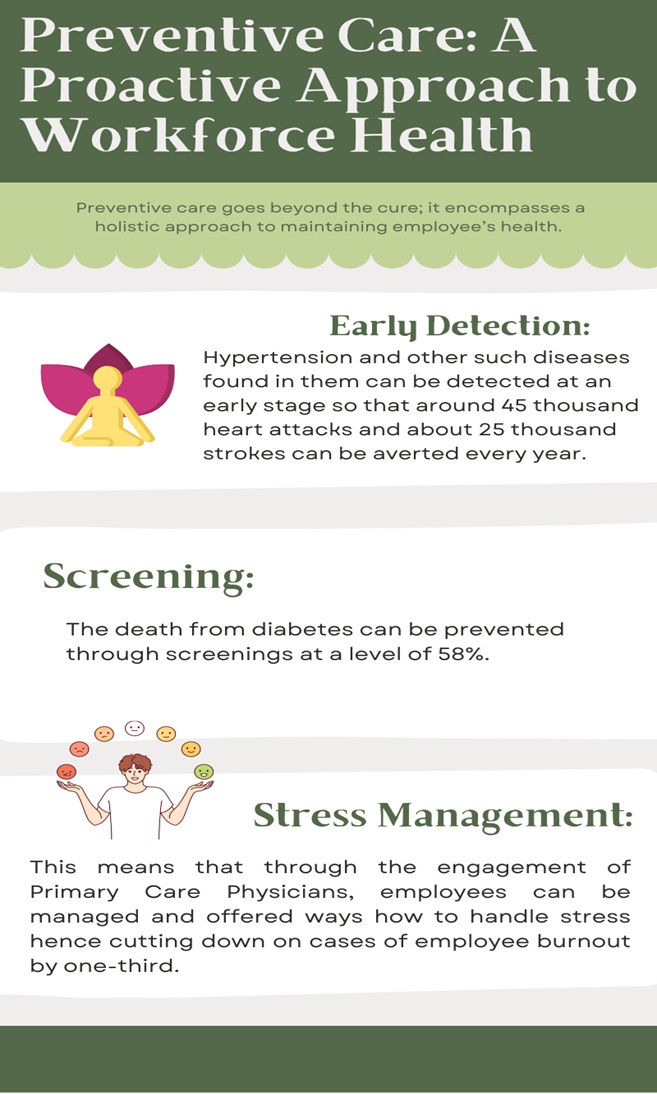Boosting Productivity: How Primary Care Physicians Improve Workforce Well-being
Today’s intense business environment has been pushing organizations to find ways to increase efficiencies and satisfy employee health. While improving mental health support has been a key focus, less attention has been given to how primary care physicians (PCPs) can support workforce well-being. For that reason, more employers integrate primary care services into their corporate wellness programs to prevent the progression of chronic diseases while enhancing employees’ mental health and, consequently, their productivity.
This blog post aims to discuss more about how and why PCPs are essential in enhancing the health of employees, the importance of integrating primary care into wellness programs, and the role of preventative measures. We should now look at how each of them can help take everyone to a higher level of health and productivity at work.
Understanding the Role of Workforce Health to Strengthen Primary Care
Since primary care is fundamental to maintaining a healthy population, it is equally essential to prioritize it within the workforce to ensure employees' well-being. By integrating primary care into workplace health initiatives, we can promote long-term health, prevent chronic illnesses, and enhance overall productivity. Primary care physicians near me are ideal for mitigating and treating chronic diseases, which are among the leading causes of morbidity and productivity loss.Diabetes, hypertension, and heart disease, among other illnesses, are estimated to cost US employers billions annually. Approximately $4 billion per year has been estimated to be the cost of lost productivity due to stress. Minimizing time lost to absenteeism: Regular visits to a PCP can reduce absenteeism by as much as 43%, making it a valuable investment for a productive workforce.
These statistics show how directly primary care physicians impact the health and, therefore, the productivity of their employees. Practical and evidence-based are the connections found between the attendance of systematic primary care checkups and a reduction in absenteeism rates; therefore, primary care plays a crucial role in an EHP.
Integrating Primary Care into Corporate Wellness Programs
Based on the effects of primary care recognized on the health of individuals as well as their performance at work, it may be seen that corporations have a stake in ensuring these services in their organized worksite health promotion programs. A well-designed wellness program with access to primary care can lead to long-term cost savings on healthcare expenses and positively impact employee turnover.
Including primary care is not about having health services and programs; it is about building a healthy organization. Employees with access to primary care find their jobs more satisfying and are thus 10% less likely to jump ship, and it all helps boost productivity.
Comparison Table: Primary Care vs. No Primary Care in Corporate Wellness Programs
|
Criteria |
With Primary Care |
Without Primary Care |
|
Absenteeism |
Reduced by up to 43% |
Higher absenteeism rates |
|
Employee Productivity |
2.5x higher productivity |
Lower productivity |
|
Healthcare Costs |
Reduced by 20% |
Higher long-term costs |
|
Employee Satisfaction |
10% higher satisfaction |
Lower job satisfaction |
|
Chronic Disease Prevention |
80% preventable through PCPs |
Higher incidence of chronic diseases |
This comparison underscores the tangible benefits of integrating primary care into wellness programs, highlighting the cost-effectiveness and overall impact on workforce well-being.
Preventive Care: A Proactive Approach to Workforce Health

Whereas weaving primary care into wellness programs is undoubtedly the preliminary step, the latter’s potential begins when one appraises the possibilities of using preventive care to prevent widespread health conditions from worsening. Preventive care goes beyond the cure; it encompasses a holistic approach to the maintenance of an employee's health.
Early Detection:
Hypertension and similar diseases can be detected early, potentially preventing around 45,000 heart attacks and 25,000 strokes annually.
Screenings: Death from diabetes can be prevented through screenings at a level of 58%.
Stress Management: By engaging primary care physicians, employees can receive support and strategies for managing stress, thereby cutting down on cases of employee burnout by one-third.
Employers can take substantial strides toward avoiding how chronic diseases appear through a particular concentration on preventive care. The detection of the initial signs of risks and constant surveillance help avoid expenses and unproductiveness as a result of diseases.
Enhancing Mental Health Through Primary Care

In the light of physical health, primary care embraces mental health, which is a very important aspect that affects productivity and employee engagement. Many employees suffer from one or another mental health problem, and this affects many organizations and the economy in general since it is estimated that mental health issues cost U.S. employers up to $100 billion in productivity loss annually.
Mental Health Services:
- Workers having access to mental health services via their PCP are 25% more likely to be ‘engaged’ at work.
- The addition of mental health to primary care can cut the symptoms of depression by half.
Arguing that it is both possible and necessary to address mental health through primary care, one cannot fail to note that it is not only the reasonable thing to do but also the right thing to do. With improved employee assistance programs, businesses can improve the mental health of their employees, which will lead to a more attentive workforce.
The Path to a Healthier and More Productive Workforce
Primary care physicians are an extremely useful asset in the improvement of productivity and the well-being of workers. Through the coordination of primary care into corporate wellness programs and taking more preventive measures on corporate US health, we can form a health management team for Corporate America’s employee workforce. The benefits are clear: integrating primary care can reduce absenteeism, increase efficiency, and result in significant savings on employee healthcare costs.
Are you all set to level up the productivity of your business? Please feel free to click here and get more information on how we can assist in delivering primary care into your wellness program and improve workforce health.
FAQs:
- Does integrating primary care services decrease total health care expenditure?
The integration of primary care services decreases the average expenditure on the consumer since it focuses on prevention and the management of long-term disorders. Primary care physicians can diagnose illnesses before complications set in, and expensive procedures have to be conducted more frequently because of complications from chronic illnesses.
- How can one influence their employees to take up primary care services most often?
Offer incentives such as reduced healthcare premiums, guaranteed time off for check-ups, and education on the importance of regular visits to encourage primary care use.
- How do primary care physicians contribute to corporate wellness programs for employees' mental health?
Primary Care Physicians work with corporate wellness programs in areas of mental health care encompassing screening, referrals, and other support for mental health disorders. This partnership makes it possible for employees to be well taken care of by getting medical care for physical ailments as well as psychological problems, thereby enhancing the quality of their work.

